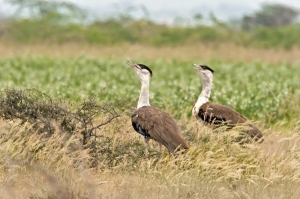Are on IUCN’s ( International Union for Conservation of Nature ) latest red list of 15 most Endangered Indian Avian s
The latest ‘red list’ of endangered bird species released by the International Union for Conservation of Nature ( IUCN ) includes 15 Indian bird species, three of which are found mainly in Gujarat. These include the Great Indian Bustard, the Indian Vulture and Siberian Cranes. All three are in the ‘critically endangered’ ( CR ) category.
Several migratory birds that come to Thol and Nalsarovar ( Gujarat ) have also been listed in the ‘vulnerable’ and ‘nearly threatened’ bird species.
Officials said the IUCN red list is the list on the basis of which several countries and states form their strategies for conversation of birds.
Officials said that the ‘International Union for Conversation of Nature Red List of Birds – 2013’ shows that 15 birds species in India continue to be in the ‘critically endangered’ category. Of these, three bird species are now in greater danger than before.
The decline in the population of these species is because of the growing human interference in areas where bird nesting and colonies exist, said the officials.
Studies by the Bombay Natural History Society ( BNHS ) and other organizations, including Wildlife Institute of India, of factors most responsible for the failing numbers of several bird species reveal that like wetlands, most other habitats such as grasslands and forests, also face severe threat due to development pressures.
The drastic loss of grassland habitat over the past decades has severely threatened species such as the Great Indian Bustard, Siberian Crane, Bengal Florican and Jerdon’s courser.
While the extensive use of diclofenac by farmers for treatment of their cattle, had led to the fall in the number of Indian Vultures, the destruction of deciduous forest had lead to the decline in the numbers of Forest owlets. The presence of chemicals in the carcass of animals on which scavenging birds feed has affected their population adversely.
BNHS – India Director, Dr. Asad Rahmani, said that on the basis of insightful scientific field research, there is an urgent need to conserve the remaining habitats and the species dependent on them.
“Policies that ensure this through sustainable development should be framed and implemented at the earliest,” Rahmani said.
Flying Away
Critically endangered species: This category in India includes migratory birds.
Wetlands species: Baer’s Pochard, Siberian crane and Spoon – billed sandpiper
Grassland Species: Bengal Florican, Great Indian Bustard, Jerdon’s courser and Sociable lapwing.
Scavengers: Indian Vulture, Red – headed vulture, White – backed vulture, Slender – billed vulture, Himaliyan quail & Pink – headed duck
Non – migratory wetland species : White – bellied heron
Forest Species: Forest owlet
Courtesy:- Times of India

